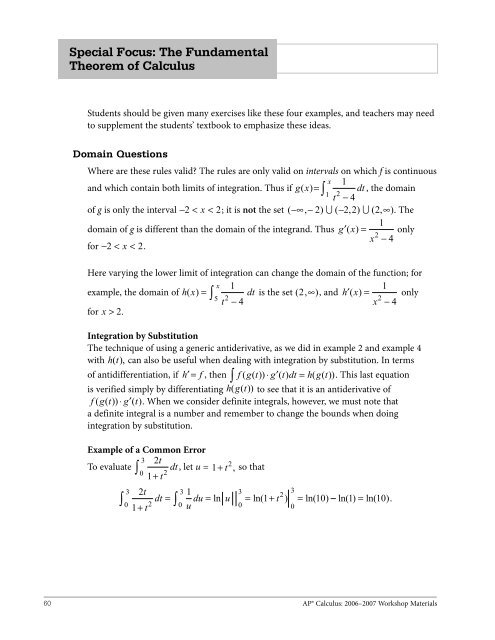AP Calculus
Calculus_SF_Theorem
Calculus_SF_Theorem
Create successful ePaper yourself
Turn your PDF publications into a flip-book with our unique Google optimized e-Paper software.
Special Focus: The Fundamental<br />
Theorem of <strong>Calculus</strong><br />
Students should be given many exercises like these four examples, and teachers may need<br />
to supplement the students’ textbook to emphasize these ideas.<br />
Domain Questions<br />
Where are these rules valid? The rules are only valid on intervals on which f is continuous<br />
x 1<br />
and which contain both limits of integration. Thus if g( x)=<br />
∫ dt , the domain<br />
1 2<br />
t − 4<br />
of g is only the interval − 2 < x < 2; it is not the set ( −∞, − 2) ∪ ( −2, 2) ∪ ( 2, ∞)<br />
. The<br />
1<br />
domain of g is different than the domain of the integrand. Thus g′ ( x)<br />
= only<br />
2<br />
x − 4<br />
for − 2 < x < 2.<br />
Here varying the lower limit of integration can change the domain of the function; for<br />
x 1<br />
1<br />
example, the domain of h( x) = ∫ dt is the set ( 2, ∞ ), and h′ ( x)<br />
= only<br />
5 2<br />
2<br />
t − 4<br />
x − 4<br />
for x > 2.<br />
Integration by Substitution<br />
The technique of using a generic antiderivative, as we did in example 2 and example 4<br />
with h( t), can also be useful when dealing with integration by substitution. In terms<br />
of antidifferentiation, if h′ = f , then ∫ f ( g( t)) ⋅ g′ ( t) dt = h( g( t))<br />
. This last equation<br />
is verified simply by differentiating h( g( t)) to see that it is an antiderivative of<br />
f ( g( t)) ⋅ g′<br />
( t)<br />
. When we consider definite integrals, however, we must note that<br />
a definite integral is a number and remember to change the bounds when doing<br />
integration by substitution.<br />
Example of a Common Error<br />
3 2t<br />
To evaluate ∫ dt , let u =<br />
2<br />
1+ t , so that<br />
0 2<br />
1+<br />
t<br />
3 2t<br />
3 1<br />
3<br />
3<br />
2<br />
dt = 1 10<br />
0 2<br />
1 t<br />
0 u du = u = +<br />
+<br />
t =<br />
0<br />
0<br />
∫ ∫ ln ln( ) ln( ) − =<br />
ln( 1) ln( 10 ).<br />
60<br />
<strong>AP</strong>® <strong>Calculus</strong>: 2006–2007 Workshop Materials


